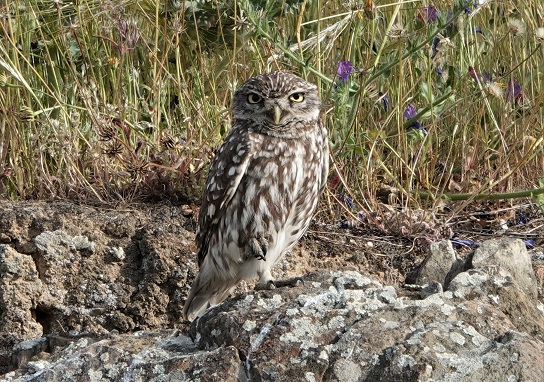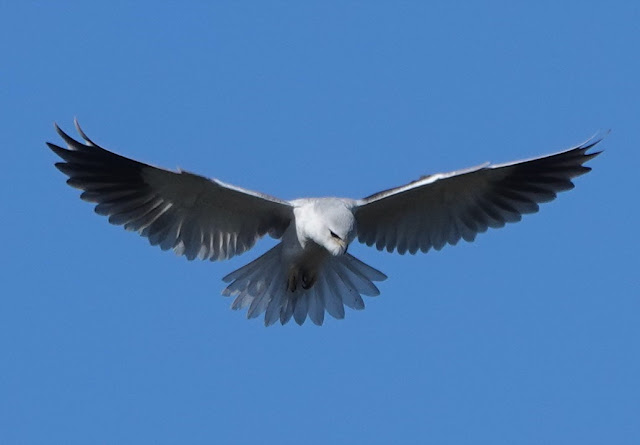 |
| Wood Sandpiper (Martin Kelsey) |
Despite a recent respite, it has been one of the longest hottest summers we have had here in Extremadura. It has stifled activity during most of the day, so if one does venture out into the afternoon heat, there is little reward. Animals have retreated to the shadows, motionless: the only sounds are cicadas and bands of Bee-eaters trooping overhead. Be out at dawn however (which at this time of the year is already well after 07.00) and it is deliciously fresh and the changes afoot can be watched in comfort and clarity. For several weeks now, waders from the Arctic tundra and boreal forests and bogs have been slipping into the Iberian Peninsula. The first were Green Sandpipers back in June, but now by mid-August, there is an arrival of other species. Gorgeous Wood Sandpipers, smaller and more refined than the Green, with daintier bills and delicately marked are here in good numbers now. Unlike the Green Sandpipers, which tend to bunker down on the remaining livestock dew ponds on the plains, or find ditches and canals, the Wood Sandpipers are in marshier habitat, which means in Extremadura, mainly irrigated rice paddies. Here they look for the few patches at field corners where the crop is sparse, or best of all a field which has lain fallow, but nevertheless has become flooded - a small muddy, sparsely vegetated patch in a sea of dense growing crops. I found such a place a few weeks ago and have been going back to it several times since. Up to about twenty Wood Sandpipers have been there on some visits, twice that number of the Ruff as well with all the different sizes and colours of this most varied of birds, along with a few other waders such as Curlew Sandpiper, Dunlin and Little Stint. The attraction is food and as the photo above shows, the water surface is covered in insects. Until just a few days ago, when I saw the first juvenile Ruff of the season, all of the waders have been adults, either failed breeders or with juveniles now independent. The latter will be making their appearance later. Parties of over a hundred Collared Pratincoles rest on this small field as well, with individuals rising to hawk the flying insects above the water, swooping, dipping and gliding. Unlike the waders, the Collared Pratincoles are a mixture of adults and the rather spotty juveniles, these are birds that have nested locally. Little Ringed Plovers step and stoop as they feed, also juveniles and adults, and a mixture of local birds with some arrivals from further north. The waders seem to synchronise their activity, busy pecking at the substrate surface followed by a wave of drowsiness as they paused to doze. A few remain vigilant and alert, tilting their heads skywards, keeping an eye as it were on the marauding Montagu's Harrier, quartering a bank a few fields away, a rich orange-plumaged juvenile.
 |
| Little Ringed Plover on the rice fields (Martin Kelsey) |
On my favourite reservoir, Alcollarín, there have been a few passage waders too, feeding along the slowly receding strandline, but the main activity here is the slow build-up of numbers of duck, almost all of them Mallard, deep in their moulting eclipse plumage and a post-breeding concentration of nearly 600 Great Crested Grebes. In late July I was there, a day after hearing that an adult Audouin's Gull had been found at a reservoir in the far south of Extremadura. I checked a group of Black-headed Gulls resting on a spit, and seeing that there was nothing unusual there, started to count the Great Crested Grebes. Once that task was complete, I took another look at the spit where amongst the Black-headed, there was now a larger, grey-brown gull, Looking at it though the telescope, its features confirmed it to be a juvenile Audouin's, my first in Extremadura and a bird which will have orginated from one of the coastal colonies in eatsern Spain. On subsequent visits I saw it or other juvenile Audouin's Gulls (sometimes two were present), part of a small influx of this maritime species into our region this summer.
 |
| Juvenile Audouin's Gull at Alcollarín Reservoir (Martin Kelsey) |






Comments